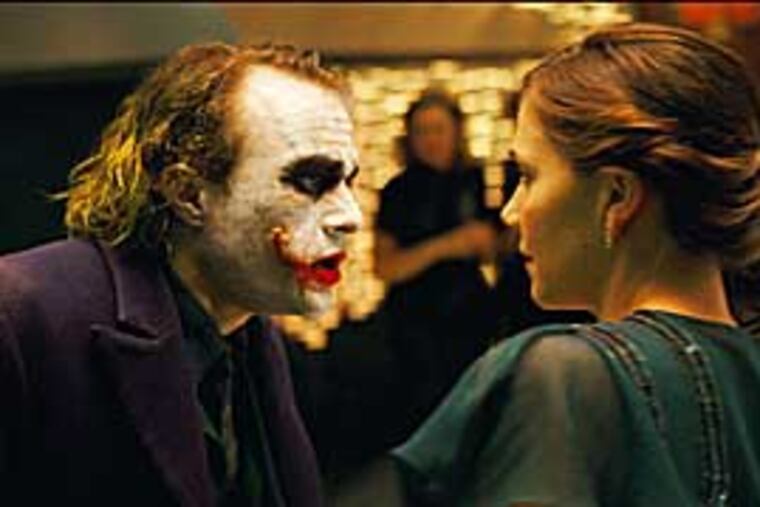Brooding, brilliant 'Dark Knight'
Bruce Wayne, gazillionaire playboy, performs a classic swan dive - from his yacht into the sapphire sparkle of the Pacific. Batman, his caped-crusader alter ego, likewise executes a wide-wingspan swoop from the silvery pinnacle of a Gotham City skyscraper down down down into the urban murk.

Bruce Wayne, gazillionaire playboy, performs a classic swan dive - from his yacht into the sapphire sparkle of the Pacific. Batman, his caped-crusader alter ego, likewise executes a wide-wingspan swoop from the silvery pinnacle of a Gotham City skyscraper down down down into the urban murk.
Can director Christopher Nolan make it any clearer that The Dark Knight, sequel to Batman Begins (2005), is about Batman's free-fall from stratospheric heights to subterranean depths?
Shakespearean but overlong, The Dark Knight is two hours of heady, involving action that devolves into a mind-numbing 32-minute epilogue.
It's a broody, moody stew of urban chaos that catches and runs with a throwaway comment once made by actor Michael Caine (who reprises his role as Alfred, Batman's servant and domestic savant). As he put it, Superman is how America sees itself and Batman is how the rest of the world sees America.
If so, and it has that clang of truth, then the world sees the States as a place where:
a) gangsters and terrorists hold cities in a grip of fear;
b) mayors and district attorneys are overwhelmed by the rising crime wave;
c) heroes and villains wear masks, and
d) the public isn't told the truth.
A grim snapshot of America in the wake of 9/11?
Nolan asks the question in another way: Can the dark and stormy knight (Christian Bale's Batman) defend Gotham City from Osama Bin Gene Simmons (Heath Ledger's Joker)?
At halftime in this Superbowl between reluctant hero and arch-villain, the Joker has the edge, in both meanings of the word. His face a smear of Kabuki-white, his eyes circled in black to suggest bottomless sockets and his mouth a slash of bloody red, the Joker is unnervingly creepy.
Anthony Perkins as Norman Bates creepy. Anthony Hopkins as Hannibal Lecter creepy. Psychotic reptile creepy. Ledger bobs his head, bares discolored fangs and flicks his tongue to intimidate and snare his prey. Initially a muscleman for mobsters (led by Eric Roberts), the Joker by his chaos freestylings becomes the undisputed king of Gotham City's underworld.
Is it sad to see the late Ledger on screen? Surprisingly, no. While the prospect of his last complete performance gave me anticipatory melancholy, 30 seconds in I responded not to Ledger-as-Joker but to the Joker himself. Believe the buzz: This unsettling, mesmerizing performance is indeed Oscar-worthy.
The Dark Knight contemplates good and evil as if they were forces illustrating Newton's Third Law of Motion. Batman's crime-busting incites the Joker's equal and opposite criminal reactions. The screenplay written by Nolan and his brother, Jonathan, is compulsively symmetrical that way. (It also results in a movie that is sadistic and unrelentingly grim, much more R than its PG-13 rating would suggest.)
As the caped crusader behind the neoprene mask and beneath the molded muscle suit, the self-contained Bale speaks in a voice-modulated rasp perilously close to Darth Vader's timbre. He moves like black lightning. His performance is complemented, eerily, by the techno thunder-rumble of a score by Hans Zimmer and James Newton Howard.
Batman believes in rules and that there are no limits to his powers. The Joker disabuses him of both conceits. To misdirect the diabolical mischief-maker, Batman and the police chief (Gary Oldman) conspire to make him believe that Batman is square-jawed district attorney Harvey Dent (a charismatic Aaron Eckhart), who is keeping company with Batman's former flame, Rachel Dawes (a wry Maggie Gyllenhaal, in the role originated by Katie Holmes). Which puts Batman in the position of making a political alliance with his romantic rival.
(When the Joker puts the moves on Rachel, it marks Ledger as the only actor to come on to both Maggie and her brother, Jake, on-screen.)
Tim Burton's 1989 Batman telegraphed its characters and conflicts in terms of their personal style. That film's fetishy retro-modern gadgets and neo-Gothic art direction served as a backdrop for Michael Keaton's minimalist Batman and Jack Nicholson's cartoonish, Barocco-loco Joker.
Released at the beginning of George H.W. Bush's presidency, Batman's meaning is essentially comic. It suggests that do-gooders are pessimistic because their job is never done and that evildoers are optimistic because there's so much bad left to be done.
Nolan's The Dark Knight emphasizes character not through personal style but through ideology, which doesn't so readily lend itself to visual cues. Order is expressed by the cold, hard surfaces of modern architecture, social vulnerability by breaking glass (the windows in skyscrapers are perpetually shattering), anarchy by the smudge and smear of the Joker's war paint and his unpredictable strikes.
The Dark Knight, which hits screens in the final months of George W. Bush's presidency, is fundamentally somber. It suggests that evildoers are inexhaustible, do-gooders exhausted, and that heroes, if they live long enough, are destined to be seen as villains.